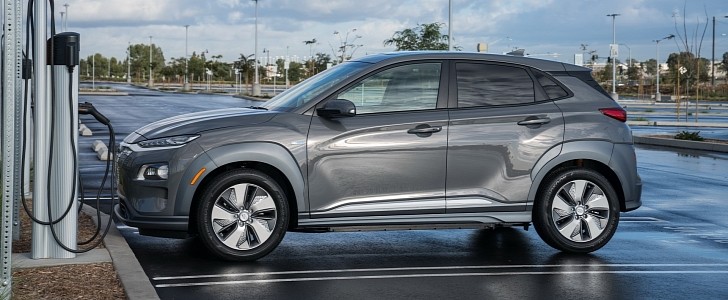Hyundai has been criticized a lot over how it handled the battery fire issue of the Kona Electric, both at home in South Korea and in the United States of America. Better late than never, the automaker has announced it’s recalling about 82,000 vehicles to the tune of $900 million.
Take a minute to work your mind around that figure. For reference, Hyundai posted a net profit of 2.12 trillion won last year, a figure that works out to $1.9 billion at the current exchange rates. In other words, nearly half of last year’s revenue will be spent on fixing the Kona Electric subcompact crossover.
LG Chem, which is the supplier of the faulty batteries, and Hyundai Motor have both agreed that a software update isn’t enough to prevent a fiery incident. Alas, all the vehicles built from November 2017 through March 2020 will have their battery packs fully replaced at no cost to the customer.
According to the Financial Times, the cells produced by LG Chem in Nanjing, China, appear to have a flaw in the cathode tabs. This condition leads to an electrical short even when the Kona Electric is turned off, which explains why so many have caught fire so far. No fewer than 14 incidents were reported since 2018, of which four took place overseas and 10 in South Korea.
Over in South Korea, the safety recall campaign will start on March 29th, according to a regulatory filing. The document also mentions that $900 million is merely an approximation. The final amount will be decided later after Hyundai settles on how to share the recall’s expenses with LG Chem.
Despite this costly hiccup, Hyundai still believes that EVs are the way forward. In addition to the Kona Electric, Ioniq family, and Nexo fuel-cell crossover, the South Korean company has recently revealed the Ioniq 5 compact crossover.
A brand-new vehicle from the roofline to the floor, the Ioniq 5 is longer than the Tucson, even though it doesn’t look like it. At launch, customers will be treated to a couple of battery options, RWD or AWD, and a WLTP-rated range of 480 kilometers (300 miles) for the most efficient variant of the lot.
LG Chem, which is the supplier of the faulty batteries, and Hyundai Motor have both agreed that a software update isn’t enough to prevent a fiery incident. Alas, all the vehicles built from November 2017 through March 2020 will have their battery packs fully replaced at no cost to the customer.
According to the Financial Times, the cells produced by LG Chem in Nanjing, China, appear to have a flaw in the cathode tabs. This condition leads to an electrical short even when the Kona Electric is turned off, which explains why so many have caught fire so far. No fewer than 14 incidents were reported since 2018, of which four took place overseas and 10 in South Korea.
Over in South Korea, the safety recall campaign will start on March 29th, according to a regulatory filing. The document also mentions that $900 million is merely an approximation. The final amount will be decided later after Hyundai settles on how to share the recall’s expenses with LG Chem.
Despite this costly hiccup, Hyundai still believes that EVs are the way forward. In addition to the Kona Electric, Ioniq family, and Nexo fuel-cell crossover, the South Korean company has recently revealed the Ioniq 5 compact crossover.
A brand-new vehicle from the roofline to the floor, the Ioniq 5 is longer than the Tucson, even though it doesn’t look like it. At launch, customers will be treated to a couple of battery options, RWD or AWD, and a WLTP-rated range of 480 kilometers (300 miles) for the most efficient variant of the lot.



















